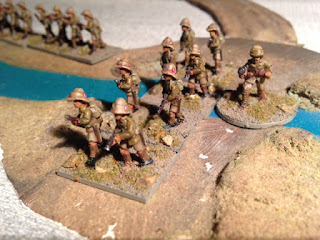It seems the blogging hiatus is over! I'm back at the painting table and have started on a new project based on the Too Fat Lardies rules -
If the Lord Spares Us - WW1 in the Middle East!
"Away from the quagmire of the Western Front ITLSU proves that brigade level games the Great War in the Middle East have components of everything; camels, arab war bands, sweeping cavalry attacks, opposed beach landings, massed machine guns, gas attacks, tanks, armoued cars, fighting in the mirage, water shortages, trench assaults, river gunboats - and enough command and control dilemmas to test the most cunning Pasha."
I'd been working on a 6mm (Irregular Miniatures) project for Gallipoli and the Middle East using Great War Spearhead II (and it's not abandoned), but I've wanted an excuse to buy some of Eureka Miniatures very nice
WW1 15mm range – who can resist the Imperial Camel Corps, after all?
To give me a little inspiration, I'm reading The Palestine Campaign by Field Marshal Earl Wavell P.C, G.C.B, G.C.S.I, G.C.I.E, M.C. (3rd Edn. by Constable, London, 1954).
My intention is to begin with the defence of the Suez and work on slowly from there.
 |
| Actions around the Suez, 1915-1916, from Wavell (1954). |
Terrain is something I'll have to get working on, but the main effort will be on painting up a few infantry battalions for the British (and her dominions) and Ottomans, then onto some mounted, artillery, and armoured cars!
I must also thank Mark Hargreaves of the
Over Open Sights for his generous provision of painting guides covering the Middle East campaigns - I strayed away from his recommendations (painting with what I had), but the inspiration was very well received. Thanks Mark!
Well, I am unashamedly a 'middle of the road' painter of miniatures - nevertheless, I enjoy it. Here's a few snaps of my first attempt. Two companies (4 bases per company in ITLSU) of the 42nd (East Lancashire) Territorial Division. These stout fellows did it all - defence of the Suez (1915), Cape Helles (May 1915 to January 1916), Egypt and the Sinai Campaign (1916 to 1917), and Western Front (1917 to the Armistice in 1918).
Their battle honours include:
- Battle of Gallipoli: Second Battle of Krithia; Third Battle of Krithia; Battle of Krithia Vineyard
- Battle of Romani
- Third Battle of Ypres
- First Battle of the Somme (1918): First Battle of Bapaume
- Second Battle of the Somme (1918): Battle of Albert (1918); Second Battle of Bapaume
- Battle of the Canal du Nord
- Battle of the Selle
But, as they say, 'Pictures! Or it didn't happen!'























































